Lakend Dairies: Talent Management Project Plan for Business Growth
VerifiedAdded on 2023/06/16
|17
|3398
|141
Report
AI Summary
This report outlines a project management plan for Lakend Dairies, a small-medium business producing diet yogurt, focusing on talent management to drive business growth. The project aims to increase awareness of diet yogurt, boost employment by 15, and improve customer access. The plan details scope, objectives, budget (£300), timeframe (10 days), and resources, addressing potential risks like Covid-19 and climate change. It includes a work breakdown structure, Gantt chart, and a questionnaire to gather primary data on talent management. Secondary data and a literature review explore the concept, benefits, and components of talent management, followed by a graph representation and analysis of questionnaire results. Recommendations for future growth and a reflection factor conclude the report, emphasizing the importance of effective project management and talent strategies.
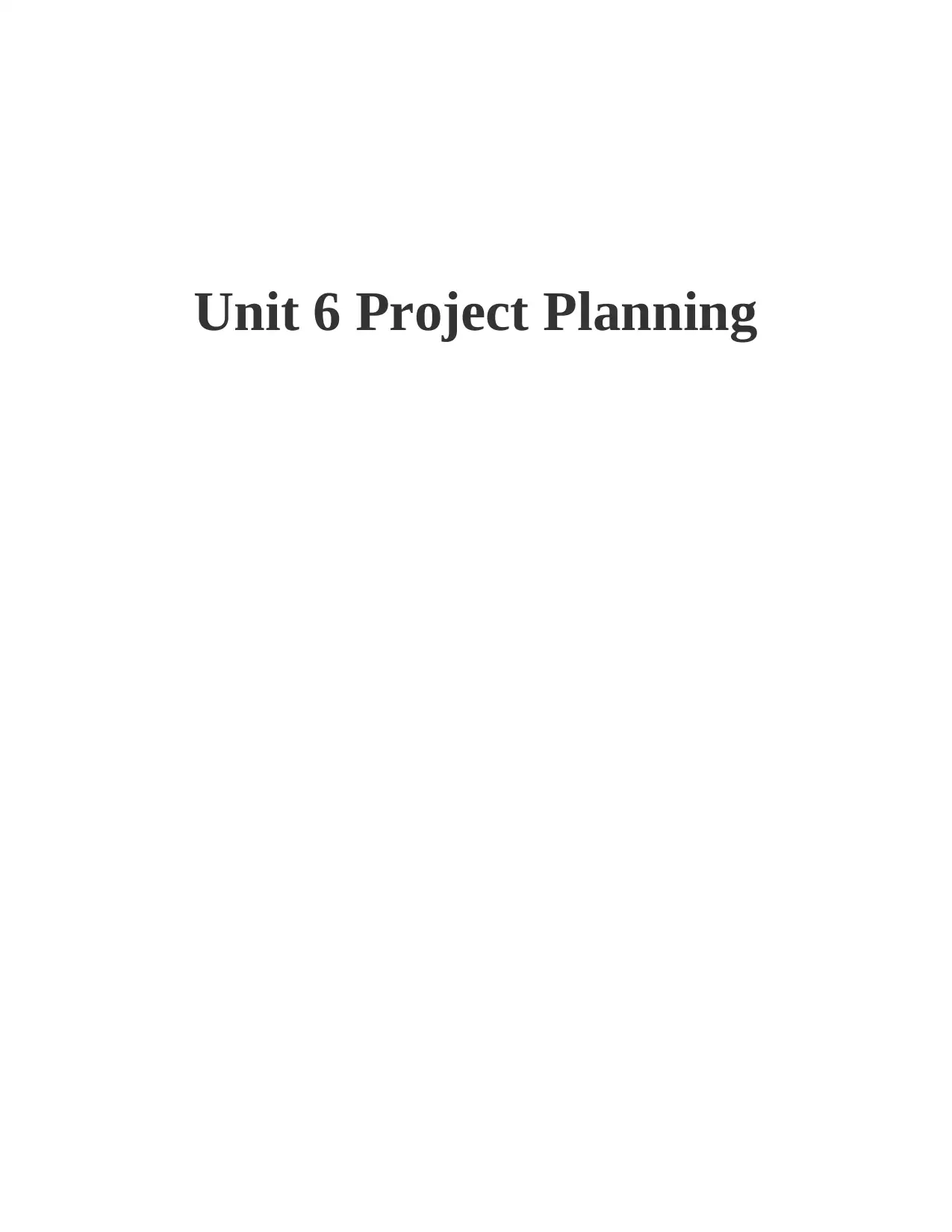
Unit 6 Project Planning
Paraphrase This Document
Need a fresh take? Get an instant paraphrase of this document with our AI Paraphraser
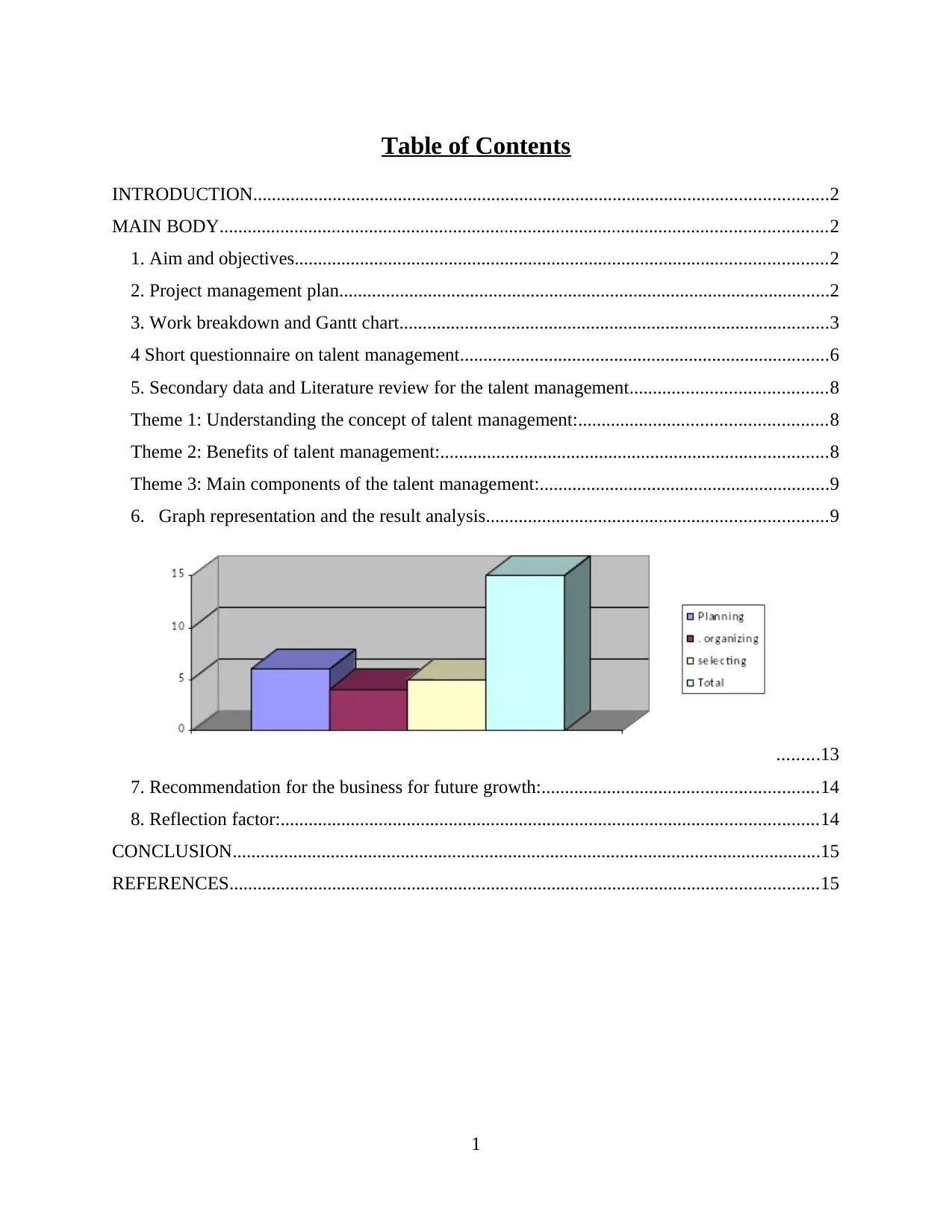
Table of Contents
INTRODUCTION...........................................................................................................................2
MAIN BODY..................................................................................................................................2
1. Aim and objectives..................................................................................................................2
2. Project management plan.........................................................................................................2
3. Work breakdown and Gantt chart............................................................................................3
4 Short questionnaire on talent management...............................................................................6
5. Secondary data and Literature review for the talent management..........................................8
Theme 1: Understanding the concept of talent management:.....................................................8
Theme 2: Benefits of talent management:...................................................................................8
Theme 3: Main components of the talent management:..............................................................9
6. Graph representation and the result analysis.........................................................................9
.........13
7. Recommendation for the business for future growth:...........................................................14
8. Reflection factor:...................................................................................................................14
CONCLUSION..............................................................................................................................15
REFERENCES..............................................................................................................................15
1
INTRODUCTION...........................................................................................................................2
MAIN BODY..................................................................................................................................2
1. Aim and objectives..................................................................................................................2
2. Project management plan.........................................................................................................2
3. Work breakdown and Gantt chart............................................................................................3
4 Short questionnaire on talent management...............................................................................6
5. Secondary data and Literature review for the talent management..........................................8
Theme 1: Understanding the concept of talent management:.....................................................8
Theme 2: Benefits of talent management:...................................................................................8
Theme 3: Main components of the talent management:..............................................................9
6. Graph representation and the result analysis.........................................................................9
.........13
7. Recommendation for the business for future growth:...........................................................14
8. Reflection factor:...................................................................................................................14
CONCLUSION..............................................................................................................................15
REFERENCES..............................................................................................................................15
1
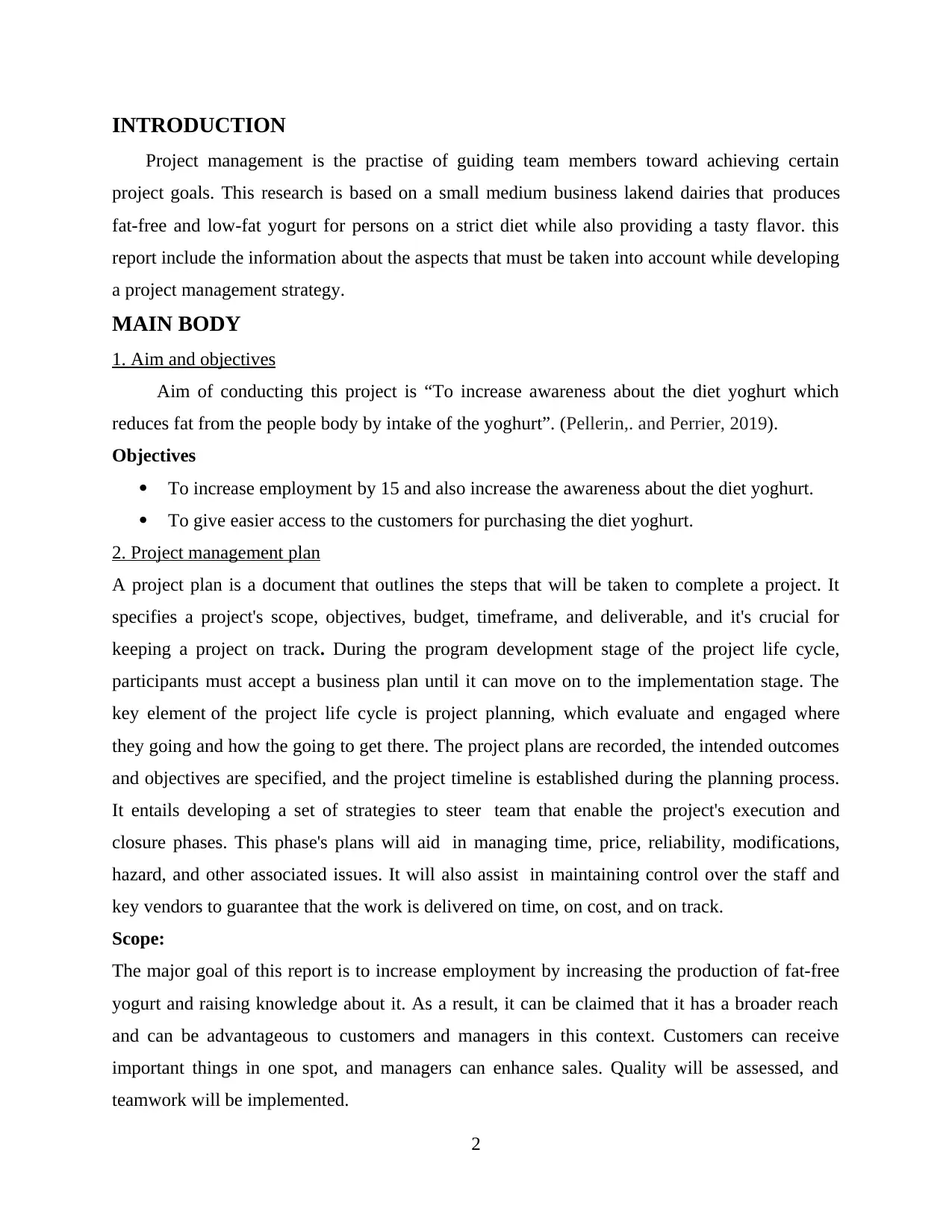
INTRODUCTION
Project management is the practise of guiding team members toward achieving certain
project goals. This research is based on a small medium business lakend dairies that produces
fat-free and low-fat yogurt for persons on a strict diet while also providing a tasty flavor. this
report include the information about the aspects that must be taken into account while developing
a project management strategy.
MAIN BODY
1. Aim and objectives
Aim of conducting this project is “To increase awareness about the diet yoghurt which
reduces fat from the people body by intake of the yoghurt”. (Pellerin,. and Perrier, 2019).
Objectives
To increase employment by 15 and also increase the awareness about the diet yoghurt.
To give easier access to the customers for purchasing the diet yoghurt.
2. Project management plan
A project plan is a document that outlines the steps that will be taken to complete a project. It
specifies a project's scope, objectives, budget, timeframe, and deliverable, and it's crucial for
keeping a project on track. During the program development stage of the project life cycle,
participants must accept a business plan until it can move on to the implementation stage. The
key element of the project life cycle is project planning, which evaluate and engaged where
they going and how the going to get there. The project plans are recorded, the intended outcomes
and objectives are specified, and the project timeline is established during the planning process.
It entails developing a set of strategies to steer team that enable the project's execution and
closure phases. This phase's plans will aid in managing time, price, reliability, modifications,
hazard, and other associated issues. It will also assist in maintaining control over the staff and
key vendors to guarantee that the work is delivered on time, on cost, and on track.
Scope:
The major goal of this report is to increase employment by increasing the production of fat-free
yogurt and raising knowledge about it. As a result, it can be claimed that it has a broader reach
and can be advantageous to customers and managers in this context. Customers can receive
important things in one spot, and managers can enhance sales. Quality will be assessed, and
teamwork will be implemented.
2
Project management is the practise of guiding team members toward achieving certain
project goals. This research is based on a small medium business lakend dairies that produces
fat-free and low-fat yogurt for persons on a strict diet while also providing a tasty flavor. this
report include the information about the aspects that must be taken into account while developing
a project management strategy.
MAIN BODY
1. Aim and objectives
Aim of conducting this project is “To increase awareness about the diet yoghurt which
reduces fat from the people body by intake of the yoghurt”. (Pellerin,. and Perrier, 2019).
Objectives
To increase employment by 15 and also increase the awareness about the diet yoghurt.
To give easier access to the customers for purchasing the diet yoghurt.
2. Project management plan
A project plan is a document that outlines the steps that will be taken to complete a project. It
specifies a project's scope, objectives, budget, timeframe, and deliverable, and it's crucial for
keeping a project on track. During the program development stage of the project life cycle,
participants must accept a business plan until it can move on to the implementation stage. The
key element of the project life cycle is project planning, which evaluate and engaged where
they going and how the going to get there. The project plans are recorded, the intended outcomes
and objectives are specified, and the project timeline is established during the planning process.
It entails developing a set of strategies to steer team that enable the project's execution and
closure phases. This phase's plans will aid in managing time, price, reliability, modifications,
hazard, and other associated issues. It will also assist in maintaining control over the staff and
key vendors to guarantee that the work is delivered on time, on cost, and on track.
Scope:
The major goal of this report is to increase employment by increasing the production of fat-free
yogurt and raising knowledge about it. As a result, it can be claimed that it has a broader reach
and can be advantageous to customers and managers in this context. Customers can receive
important things in one spot, and managers can enhance sales. Quality will be assessed, and
teamwork will be implemented.
2
⊘ This is a preview!⊘
Do you want full access?
Subscribe today to unlock all pages.

Trusted by 1+ million students worldwide
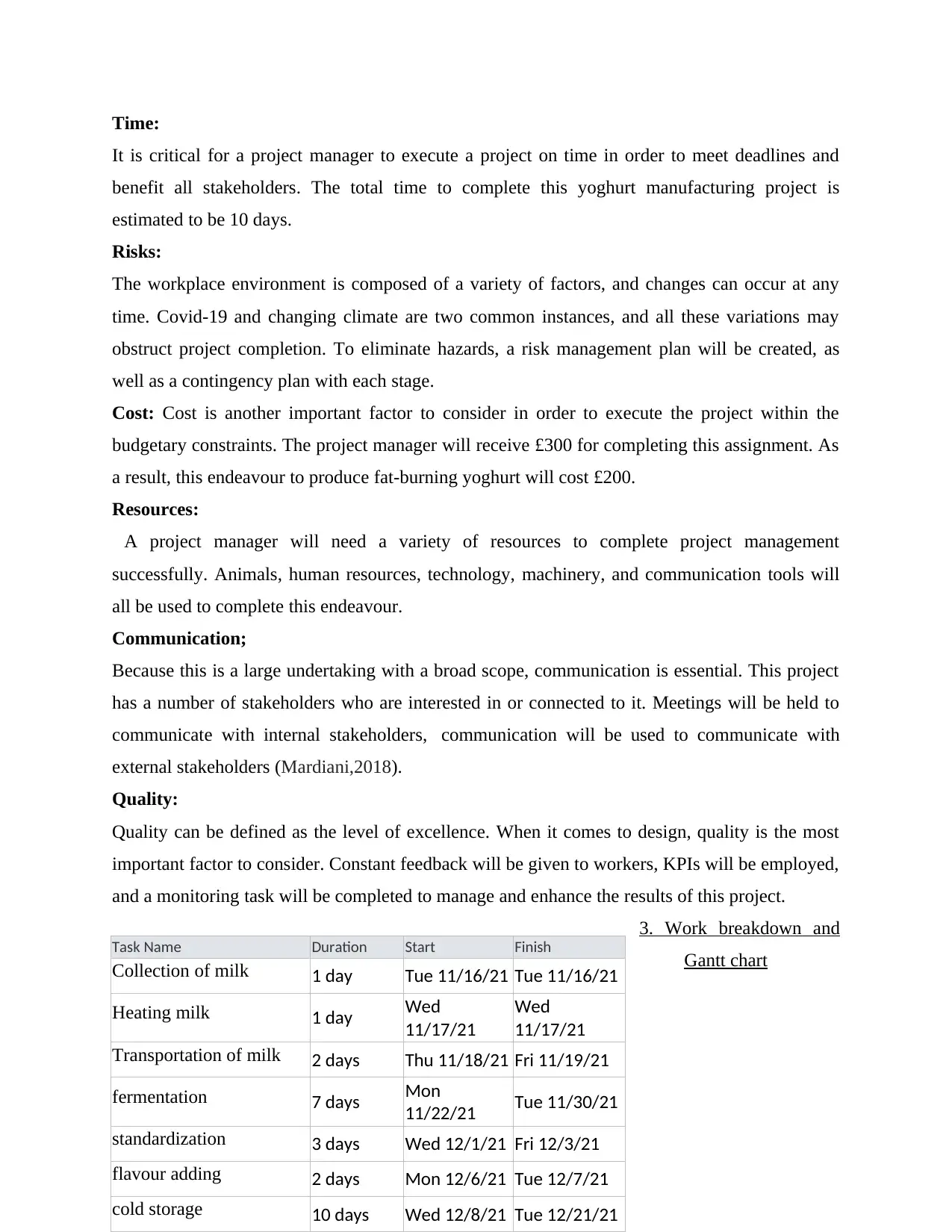
Time:
It is critical for a project manager to execute a project on time in order to meet deadlines and
benefit all stakeholders. The total time to complete this yoghurt manufacturing project is
estimated to be 10 days.
Risks:
The workplace environment is composed of a variety of factors, and changes can occur at any
time. Covid-19 and changing climate are two common instances, and all these variations may
obstruct project completion. To eliminate hazards, a risk management plan will be created, as
well as a contingency plan with each stage.
Cost: Cost is another important factor to consider in order to execute the project within the
budgetary constraints. The project manager will receive £300 for completing this assignment. As
a result, this endeavour to produce fat-burning yoghurt will cost £200.
Resources:
A project manager will need a variety of resources to complete project management
successfully. Animals, human resources, technology, machinery, and communication tools will
all be used to complete this endeavour.
Communication;
Because this is a large undertaking with a broad scope, communication is essential. This project
has a number of stakeholders who are interested in or connected to it. Meetings will be held to
communicate with internal stakeholders, communication will be used to communicate with
external stakeholders (Mardiani,2018).
Quality:
Quality can be defined as the level of excellence. When it comes to design, quality is the most
important factor to consider. Constant feedback will be given to workers, KPIs will be employed,
and a monitoring task will be completed to manage and enhance the results of this project.
3. Work breakdown and
Gantt chart
3
Task Name Duration Start Finish
Collection of milk 1 day Tue 11/16/21 Tue 11/16/21
Heating milk 1 day Wed
11/17/21
Wed
11/17/21
Transportation of milk 2 days Thu 11/18/21 Fri 11/19/21
fermentation 7 days Mon
11/22/21 Tue 11/30/21
standardization 3 days Wed 12/1/21 Fri 12/3/21
flavour adding 2 days Mon 12/6/21 Tue 12/7/21
cold storage 10 days Wed 12/8/21 Tue 12/21/21
It is critical for a project manager to execute a project on time in order to meet deadlines and
benefit all stakeholders. The total time to complete this yoghurt manufacturing project is
estimated to be 10 days.
Risks:
The workplace environment is composed of a variety of factors, and changes can occur at any
time. Covid-19 and changing climate are two common instances, and all these variations may
obstruct project completion. To eliminate hazards, a risk management plan will be created, as
well as a contingency plan with each stage.
Cost: Cost is another important factor to consider in order to execute the project within the
budgetary constraints. The project manager will receive £300 for completing this assignment. As
a result, this endeavour to produce fat-burning yoghurt will cost £200.
Resources:
A project manager will need a variety of resources to complete project management
successfully. Animals, human resources, technology, machinery, and communication tools will
all be used to complete this endeavour.
Communication;
Because this is a large undertaking with a broad scope, communication is essential. This project
has a number of stakeholders who are interested in or connected to it. Meetings will be held to
communicate with internal stakeholders, communication will be used to communicate with
external stakeholders (Mardiani,2018).
Quality:
Quality can be defined as the level of excellence. When it comes to design, quality is the most
important factor to consider. Constant feedback will be given to workers, KPIs will be employed,
and a monitoring task will be completed to manage and enhance the results of this project.
3. Work breakdown and
Gantt chart
3
Task Name Duration Start Finish
Collection of milk 1 day Tue 11/16/21 Tue 11/16/21
Heating milk 1 day Wed
11/17/21
Wed
11/17/21
Transportation of milk 2 days Thu 11/18/21 Fri 11/19/21
fermentation 7 days Mon
11/22/21 Tue 11/30/21
standardization 3 days Wed 12/1/21 Fri 12/3/21
flavour adding 2 days Mon 12/6/21 Tue 12/7/21
cold storage 10 days Wed 12/8/21 Tue 12/21/21
Paraphrase This Document
Need a fresh take? Get an instant paraphrase of this document with our AI Paraphraser

4

5
⊘ This is a preview!⊘
Do you want full access?
Subscribe today to unlock all pages.

Trusted by 1+ million students worldwide
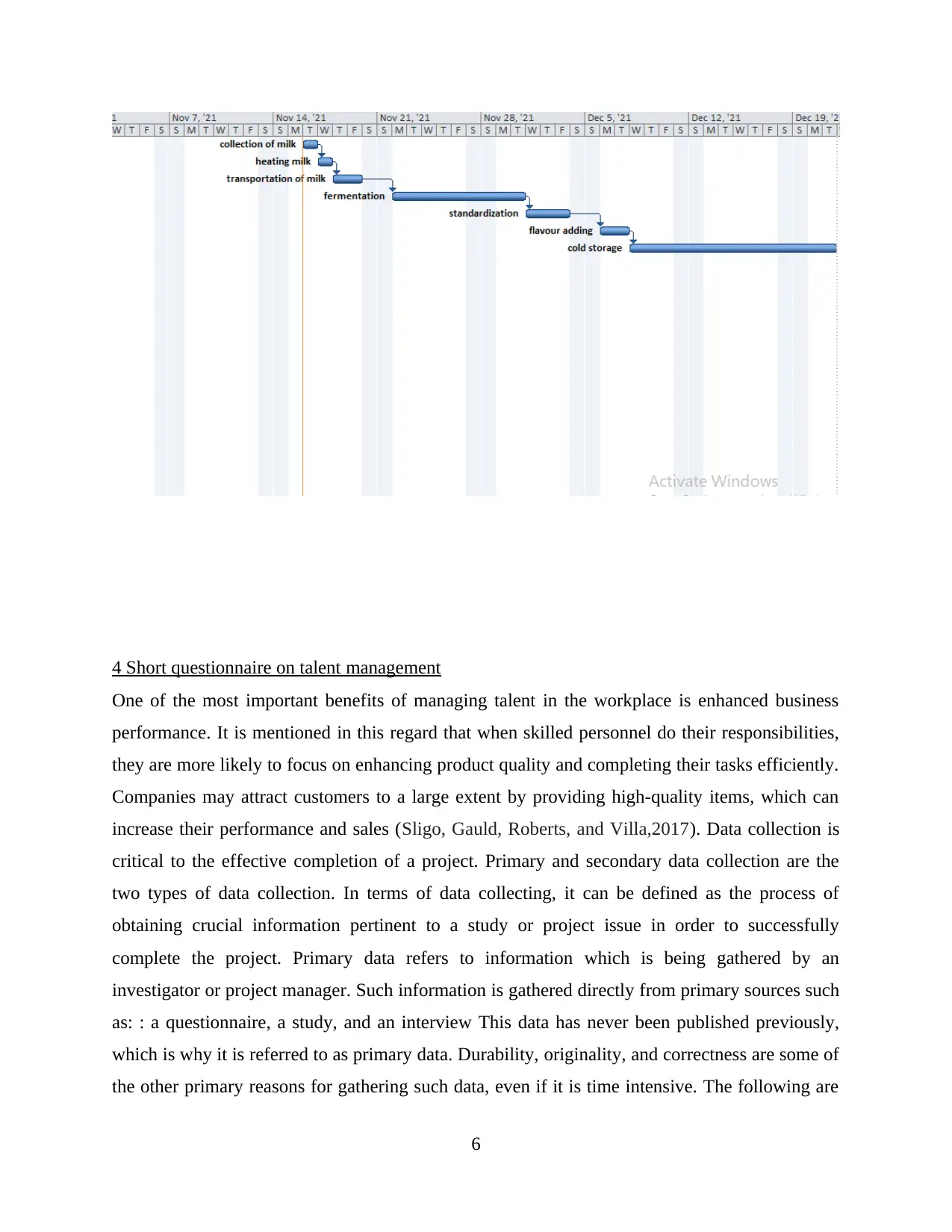
4 Short questionnaire on talent management
One of the most important benefits of managing talent in the workplace is enhanced business
performance. It is mentioned in this regard that when skilled personnel do their responsibilities,
they are more likely to focus on enhancing product quality and completing their tasks efficiently.
Companies may attract customers to a large extent by providing high-quality items, which can
increase their performance and sales (Sligo, Gauld, Roberts, and Villa,2017). Data collection is
critical to the effective completion of a project. Primary and secondary data collection are the
two types of data collection. In terms of data collecting, it can be defined as the process of
obtaining crucial information pertinent to a study or project issue in order to successfully
complete the project. Primary data refers to information which is being gathered by an
investigator or project manager. Such information is gathered directly from primary sources such
as: : a questionnaire, a study, and an interview This data has never been published previously,
which is why it is referred to as primary data. Durability, originality, and correctness are some of
the other primary reasons for gathering such data, even if it is time intensive. The following are
6
One of the most important benefits of managing talent in the workplace is enhanced business
performance. It is mentioned in this regard that when skilled personnel do their responsibilities,
they are more likely to focus on enhancing product quality and completing their tasks efficiently.
Companies may attract customers to a large extent by providing high-quality items, which can
increase their performance and sales (Sligo, Gauld, Roberts, and Villa,2017). Data collection is
critical to the effective completion of a project. Primary and secondary data collection are the
two types of data collection. In terms of data collecting, it can be defined as the process of
obtaining crucial information pertinent to a study or project issue in order to successfully
complete the project. Primary data refers to information which is being gathered by an
investigator or project manager. Such information is gathered directly from primary sources such
as: : a questionnaire, a study, and an interview This data has never been published previously,
which is why it is referred to as primary data. Durability, originality, and correctness are some of
the other primary reasons for gathering such data, even if it is time intensive. The following are
6
Paraphrase This Document
Need a fresh take? Get an instant paraphrase of this document with our AI Paraphraser
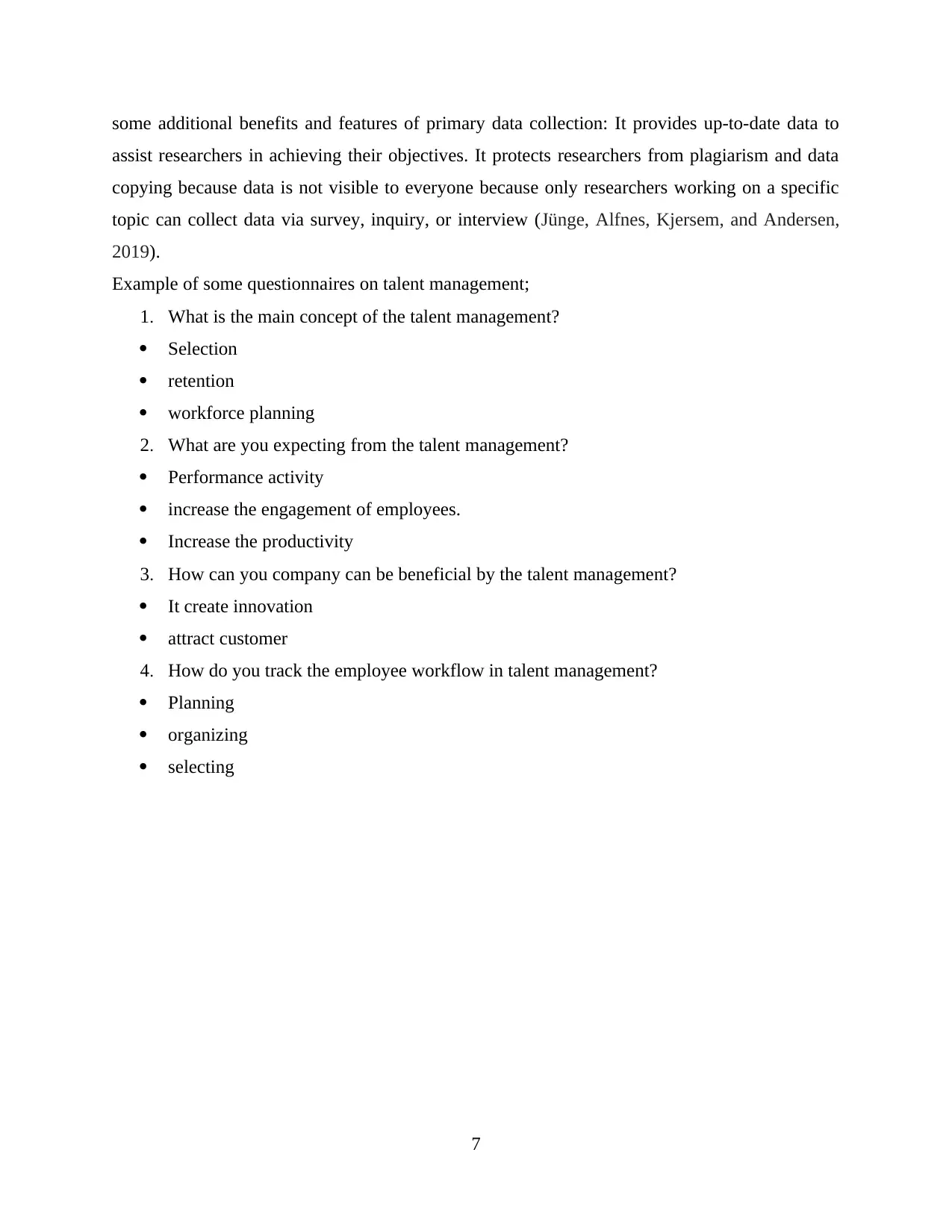
some additional benefits and features of primary data collection: It provides up-to-date data to
assist researchers in achieving their objectives. It protects researchers from plagiarism and data
copying because data is not visible to everyone because only researchers working on a specific
topic can collect data via survey, inquiry, or interview (Jünge, Alfnes, Kjersem, and Andersen,
2019).
Example of some questionnaires on talent management;
1. What is the main concept of the talent management?
Selection
retention
workforce planning
2. What are you expecting from the talent management?
Performance activity
increase the engagement of employees.
Increase the productivity
3. How can you company can be beneficial by the talent management?
It create innovation
attract customer
4. How do you track the employee workflow in talent management?
Planning
organizing
selecting
7
assist researchers in achieving their objectives. It protects researchers from plagiarism and data
copying because data is not visible to everyone because only researchers working on a specific
topic can collect data via survey, inquiry, or interview (Jünge, Alfnes, Kjersem, and Andersen,
2019).
Example of some questionnaires on talent management;
1. What is the main concept of the talent management?
Selection
retention
workforce planning
2. What are you expecting from the talent management?
Performance activity
increase the engagement of employees.
Increase the productivity
3. How can you company can be beneficial by the talent management?
It create innovation
attract customer
4. How do you track the employee workflow in talent management?
Planning
organizing
selecting
7
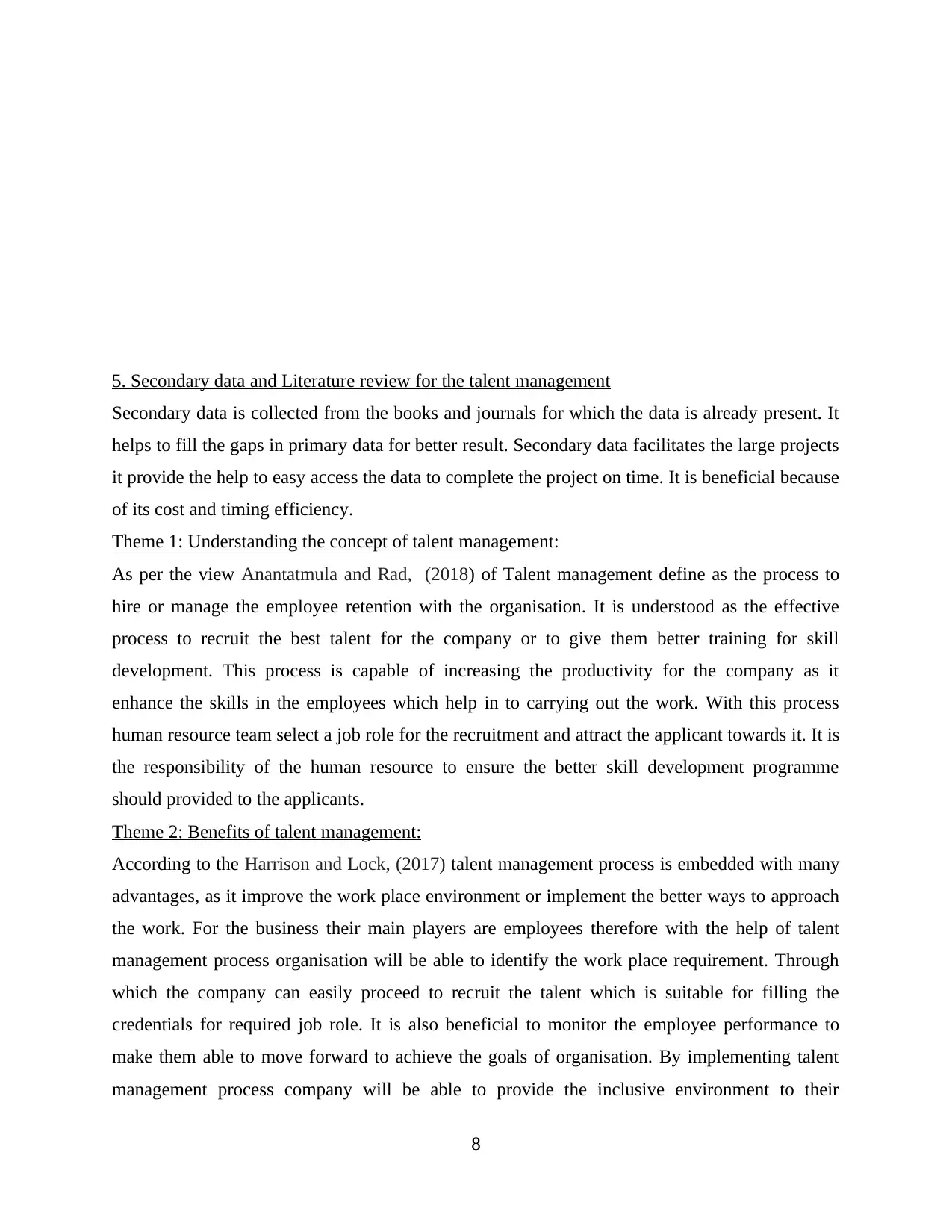
5. Secondary data and Literature review for the talent management
Secondary data is collected from the books and journals for which the data is already present. It
helps to fill the gaps in primary data for better result. Secondary data facilitates the large projects
it provide the help to easy access the data to complete the project on time. It is beneficial because
of its cost and timing efficiency.
Theme 1: Understanding the concept of talent management:
As per the view Anantatmula and Rad, (2018) of Talent management define as the process to
hire or manage the employee retention with the organisation. It is understood as the effective
process to recruit the best talent for the company or to give them better training for skill
development. This process is capable of increasing the productivity for the company as it
enhance the skills in the employees which help in to carrying out the work. With this process
human resource team select a job role for the recruitment and attract the applicant towards it. It is
the responsibility of the human resource to ensure the better skill development programme
should provided to the applicants.
Theme 2: Benefits of talent management:
According to the Harrison and Lock, (2017) talent management process is embedded with many
advantages, as it improve the work place environment or implement the better ways to approach
the work. For the business their main players are employees therefore with the help of talent
management process organisation will be able to identify the work place requirement. Through
which the company can easily proceed to recruit the talent which is suitable for filling the
credentials for required job role. It is also beneficial to monitor the employee performance to
make them able to move forward to achieve the goals of organisation. By implementing talent
management process company will be able to provide the inclusive environment to their
8
Secondary data is collected from the books and journals for which the data is already present. It
helps to fill the gaps in primary data for better result. Secondary data facilitates the large projects
it provide the help to easy access the data to complete the project on time. It is beneficial because
of its cost and timing efficiency.
Theme 1: Understanding the concept of talent management:
As per the view Anantatmula and Rad, (2018) of Talent management define as the process to
hire or manage the employee retention with the organisation. It is understood as the effective
process to recruit the best talent for the company or to give them better training for skill
development. This process is capable of increasing the productivity for the company as it
enhance the skills in the employees which help in to carrying out the work. With this process
human resource team select a job role for the recruitment and attract the applicant towards it. It is
the responsibility of the human resource to ensure the better skill development programme
should provided to the applicants.
Theme 2: Benefits of talent management:
According to the Harrison and Lock, (2017) talent management process is embedded with many
advantages, as it improve the work place environment or implement the better ways to approach
the work. For the business their main players are employees therefore with the help of talent
management process organisation will be able to identify the work place requirement. Through
which the company can easily proceed to recruit the talent which is suitable for filling the
credentials for required job role. It is also beneficial to monitor the employee performance to
make them able to move forward to achieve the goals of organisation. By implementing talent
management process company will be able to provide the inclusive environment to their
8
⊘ This is a preview!⊘
Do you want full access?
Subscribe today to unlock all pages.

Trusted by 1+ million students worldwide
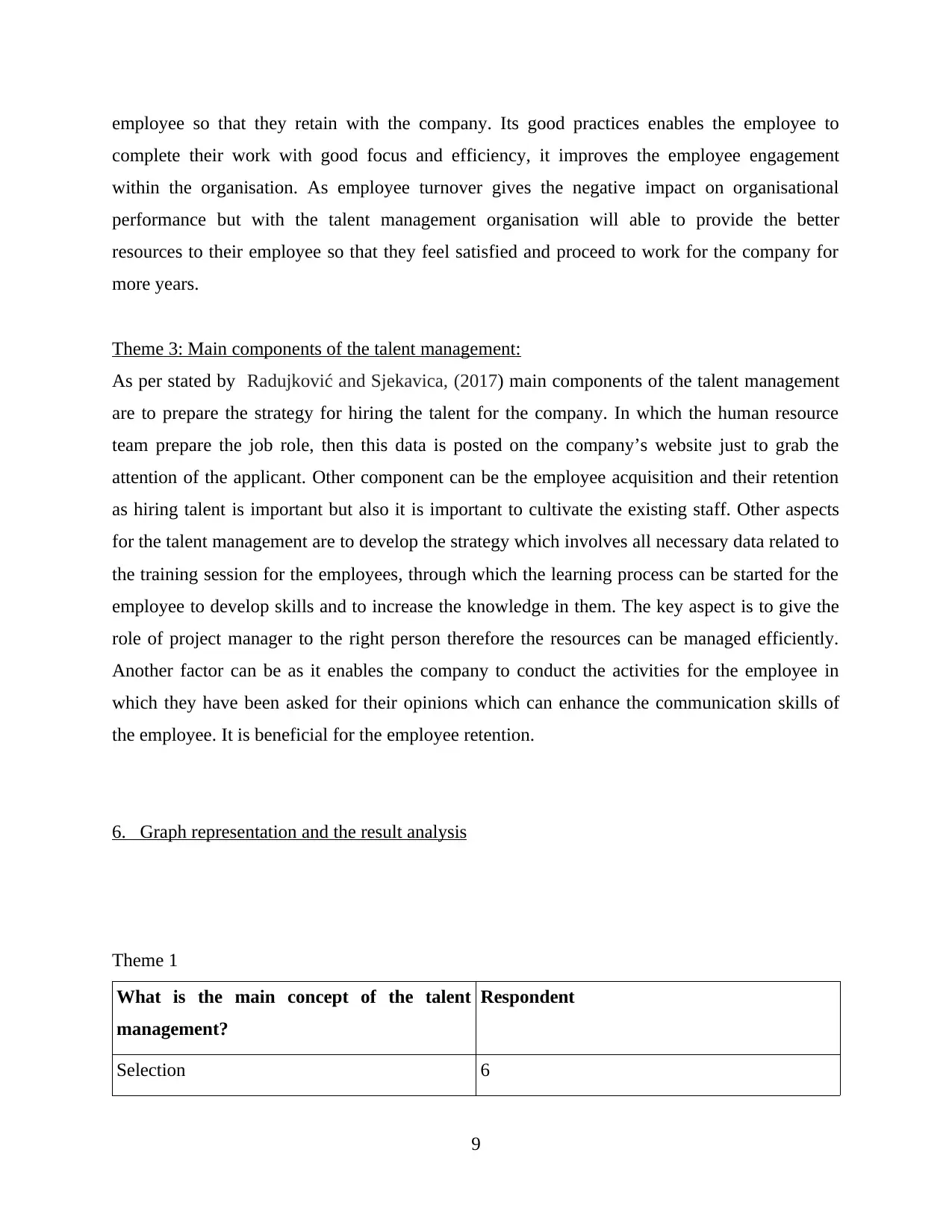
employee so that they retain with the company. Its good practices enables the employee to
complete their work with good focus and efficiency, it improves the employee engagement
within the organisation. As employee turnover gives the negative impact on organisational
performance but with the talent management organisation will able to provide the better
resources to their employee so that they feel satisfied and proceed to work for the company for
more years.
Theme 3: Main components of the talent management:
As per stated by Radujković and Sjekavica, (2017) main components of the talent management
are to prepare the strategy for hiring the talent for the company. In which the human resource
team prepare the job role, then this data is posted on the company’s website just to grab the
attention of the applicant. Other component can be the employee acquisition and their retention
as hiring talent is important but also it is important to cultivate the existing staff. Other aspects
for the talent management are to develop the strategy which involves all necessary data related to
the training session for the employees, through which the learning process can be started for the
employee to develop skills and to increase the knowledge in them. The key aspect is to give the
role of project manager to the right person therefore the resources can be managed efficiently.
Another factor can be as it enables the company to conduct the activities for the employee in
which they have been asked for their opinions which can enhance the communication skills of
the employee. It is beneficial for the employee retention.
6. Graph representation and the result analysis
Theme 1
What is the main concept of the talent
management?
Respondent
Selection 6
9
complete their work with good focus and efficiency, it improves the employee engagement
within the organisation. As employee turnover gives the negative impact on organisational
performance but with the talent management organisation will able to provide the better
resources to their employee so that they feel satisfied and proceed to work for the company for
more years.
Theme 3: Main components of the talent management:
As per stated by Radujković and Sjekavica, (2017) main components of the talent management
are to prepare the strategy for hiring the talent for the company. In which the human resource
team prepare the job role, then this data is posted on the company’s website just to grab the
attention of the applicant. Other component can be the employee acquisition and their retention
as hiring talent is important but also it is important to cultivate the existing staff. Other aspects
for the talent management are to develop the strategy which involves all necessary data related to
the training session for the employees, through which the learning process can be started for the
employee to develop skills and to increase the knowledge in them. The key aspect is to give the
role of project manager to the right person therefore the resources can be managed efficiently.
Another factor can be as it enables the company to conduct the activities for the employee in
which they have been asked for their opinions which can enhance the communication skills of
the employee. It is beneficial for the employee retention.
6. Graph representation and the result analysis
Theme 1
What is the main concept of the talent
management?
Respondent
Selection 6
9
Paraphrase This Document
Need a fresh take? Get an instant paraphrase of this document with our AI Paraphraser
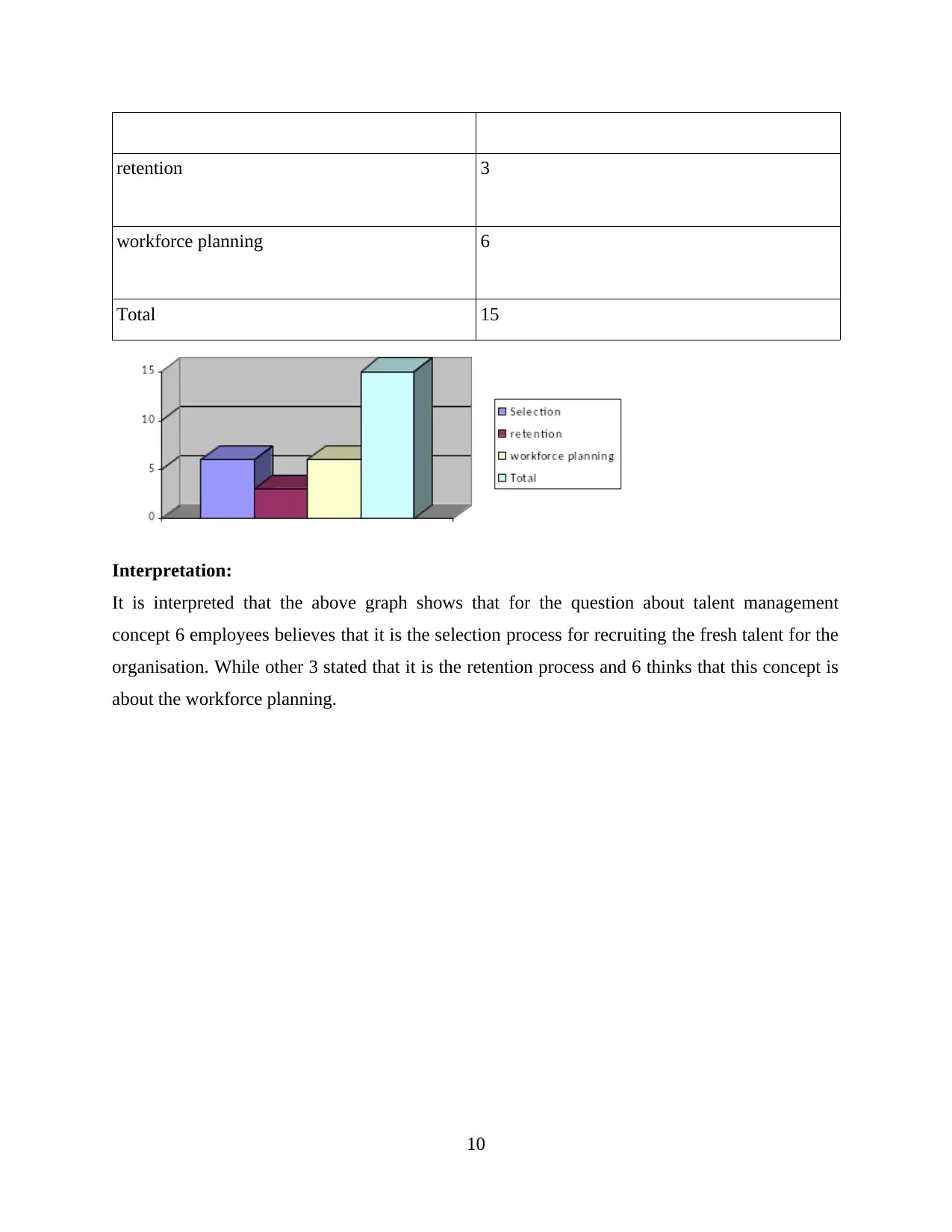
retention 3
workforce planning 6
Total 15
Interpretation:
It is interpreted that the above graph shows that for the question about talent management
concept 6 employees believes that it is the selection process for recruiting the fresh talent for the
organisation. While other 3 stated that it is the retention process and 6 thinks that this concept is
about the workforce planning.
10
workforce planning 6
Total 15
Interpretation:
It is interpreted that the above graph shows that for the question about talent management
concept 6 employees believes that it is the selection process for recruiting the fresh talent for the
organisation. While other 3 stated that it is the retention process and 6 thinks that this concept is
about the workforce planning.
10
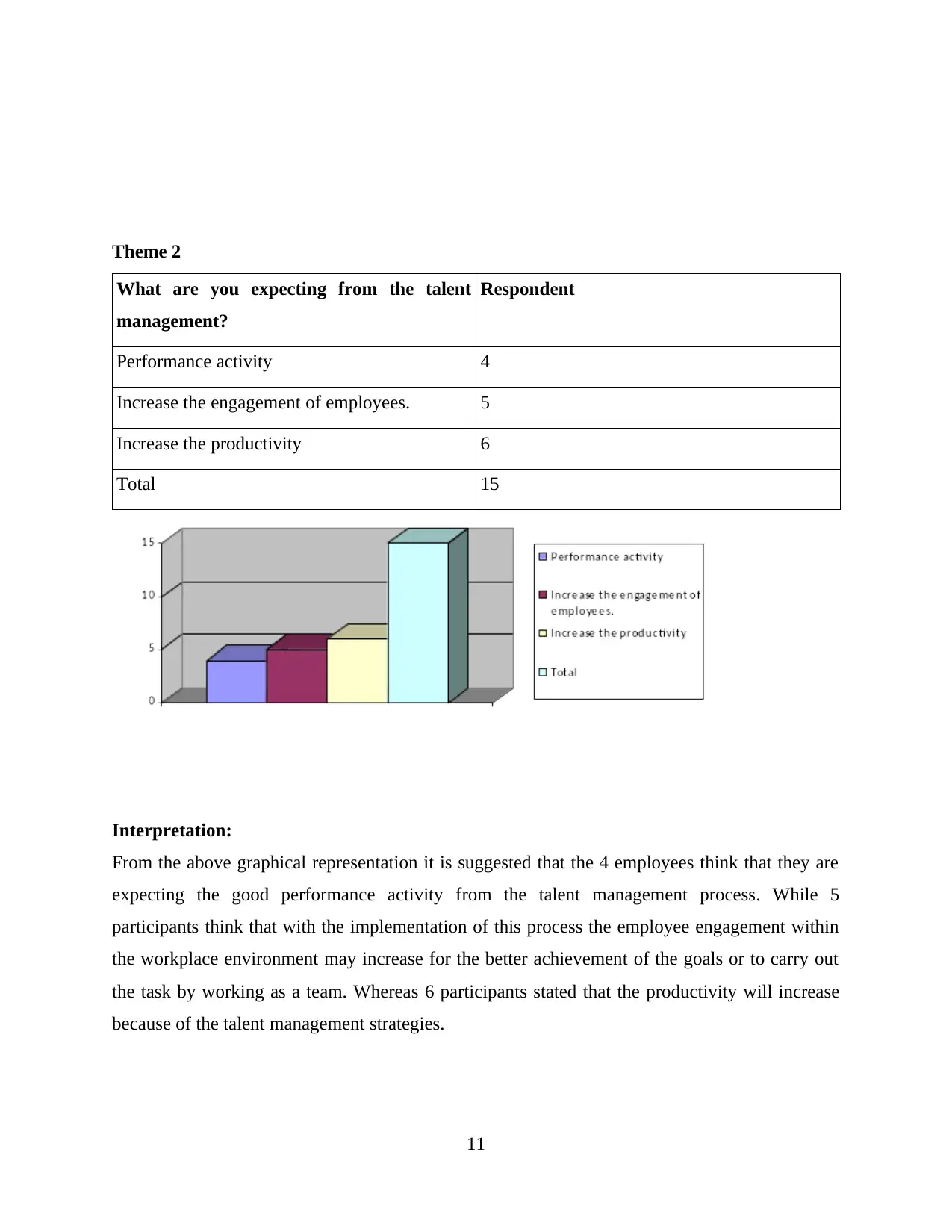
Theme 2
What are you expecting from the talent
management?
Respondent
Performance activity 4
Increase the engagement of employees. 5
Increase the productivity 6
Total 15
Interpretation:
From the above graphical representation it is suggested that the 4 employees think that they are
expecting the good performance activity from the talent management process. While 5
participants think that with the implementation of this process the employee engagement within
the workplace environment may increase for the better achievement of the goals or to carry out
the task by working as a team. Whereas 6 participants stated that the productivity will increase
because of the talent management strategies.
11
What are you expecting from the talent
management?
Respondent
Performance activity 4
Increase the engagement of employees. 5
Increase the productivity 6
Total 15
Interpretation:
From the above graphical representation it is suggested that the 4 employees think that they are
expecting the good performance activity from the talent management process. While 5
participants think that with the implementation of this process the employee engagement within
the workplace environment may increase for the better achievement of the goals or to carry out
the task by working as a team. Whereas 6 participants stated that the productivity will increase
because of the talent management strategies.
11
⊘ This is a preview!⊘
Do you want full access?
Subscribe today to unlock all pages.

Trusted by 1+ million students worldwide
1 out of 17
Related Documents
Your All-in-One AI-Powered Toolkit for Academic Success.
+13062052269
info@desklib.com
Available 24*7 on WhatsApp / Email
![[object Object]](/_next/static/media/star-bottom.7253800d.svg)
Unlock your academic potential
Copyright © 2020–2025 A2Z Services. All Rights Reserved. Developed and managed by ZUCOL.




